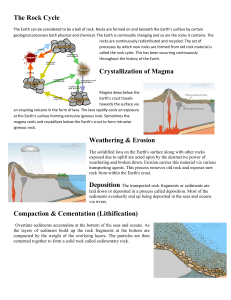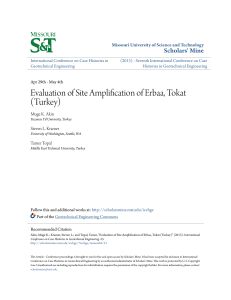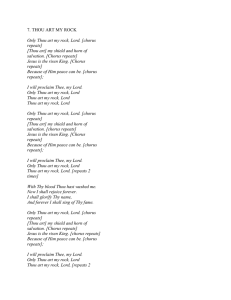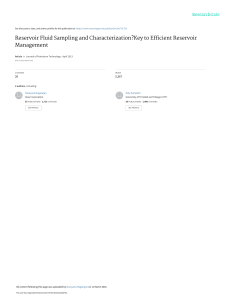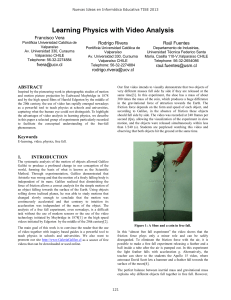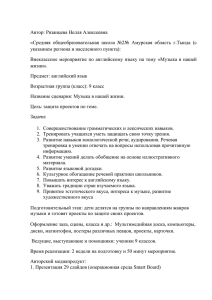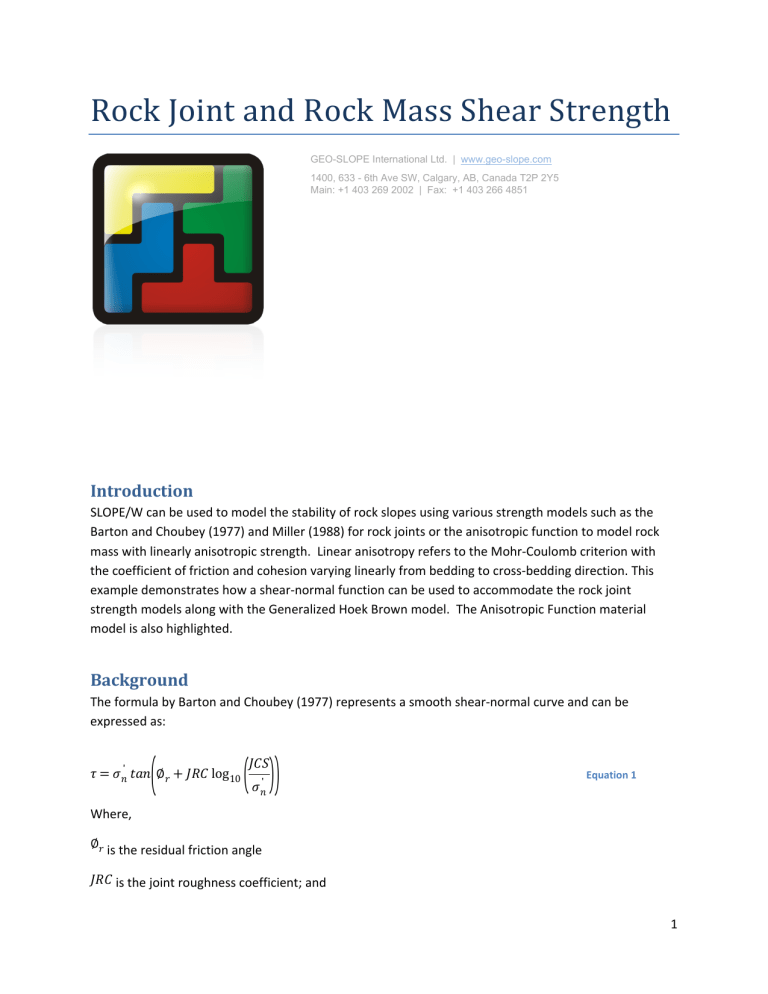
Rock Joint and Rock Mass Shear Strength GEO-SLOPE International Ltd. | www.geo-slope.com 1400, 633 - 6th Ave SW, Calgary, AB, Canada T2P 2Y5 Main: +1 403 269 2002 | Fax: +1 403 266 4851 Introduction SLOPE/W can be used to model the stability of rock slopes using various strength models such as the Barton and Choubey (1977) and Miller (1988) for rock joints or the anisotropic function to model rock mass with linearly anisotropic strength. Linear anisotropy refers to the Mohr-Coulomb criterion with the coefficient of friction and cohesion varying linearly from bedding to cross-bedding direction. This example demonstrates how a shear-normal function can be used to accommodate the rock joint strength models along with the Generalized Hoek Brown model. The Anisotropic Function material model is also highlighted. Background The formula by Barton and Choubey (1977) represents a smooth shear-normal curve and can be expressed as: ( 𝜏 = 𝜎𝑛' 𝑡𝑎𝑛 ∅𝑟 + 𝐽𝑅𝐶 log10 ( )) 𝐽𝐶𝑆 𝜎𝑛' Equation 1 Where, ∅𝑟 is the residual friction angle 𝐽𝑅𝐶 is the joint roughness coefficient; and 1 𝐽𝐶𝑆 is the joint wall compressive strength log10 Note that the second term in the bracket of Equation 1 cannot be negative (i.e. ( ) 𝐽𝐶𝑆 𝜎𝑛' ≥0 ). Miller (1988) proposed the following formula to represent the shear strength at low normal stresses in rock: 𝜏 = 𝑎(𝜎𝑛' + 𝑑)𝑏 + 𝑐 + 𝜎𝑛' 𝑡𝑎𝑛(𝜃𝑤) Equation 2 Where, 𝑎, 𝑏,𝑐, 𝑎𝑛𝑑 𝑑 are curve parameters; and 𝜃𝑤 is the “waviness angle” when the formula is used to model the shear strength of a rock joint Numerical Simulation Figure 1 presents the geometry of the numerical model. The domain was divided into two regions for the convenience of modeling rock joint. There are three analyses in the GeoStudio Project. In the first analysis, the top region is modelled using a Generalized Hoek-Brown material model, while the lower region is defined using a Barton and Choubey (1977) function. The second analysis makes use of Miller (1988) to model the jointed rock, while the third analysis applies an Anisotropic Function to the entire domain. 80 Materials Generalized Hoek-Brown Barton and Choubey 70 60 Elevation (m) 50 40 30 20 10 0 -10 -20 -60 -50 -40 -30 -20 -10 0 10 20 30 40 50 60 70 80 90 100 110 120 Distance (m) Figure 1. The geometry of the rock slope. 2 Pairs of shear and normal stresses were generated in an Excel spreadsheet based on Equation 1. The data points were copied from Excel and pasted into the KeyIn Shear/Normal Strength Function window of SLOPE/W (Figure 2). The procedure of using Miller’s formula was the same as for the BartonChoubey model described above. Figure 2. Barton and Choubey (1977) model (JRC = 8, JCS = 4000 kPa, r = 20 deg) generated using Shear/Normal Function in SLOPE/W. The linear anisotropy for Case 3 is illustrated in Figure 3. The bedding plane angle was assumed to be 11 degrees counter clockwise from horizontal. The cohesion and friction angle were assumed to be: 𝑐 = 30 kPa and ∅ = 24 degrees within ± 5 degrees of the bedding plane; and 𝑐 = 150 kPa and ∅ = 36 degrees within ± 75 degrees of the cross-bedding, respectively. Note that the coefficient of friction was assumed to be linearly anisotropic herein. 3 Figure 3. Assumed linearly anisotropic rock mass shear strength. The Anisotropic Function curves that were created for SLOPE/W are presented in Figure 4. Note that in SLOPE/W, the Anisotropic Function is applied to friction angle (rather than coefficient of friction). Figure 4. Cohesion and friction angle anisotropic Functions. Results and Discussion Figure 5 presents the factor of safety and critical slip surface for Case 1, in which the rock joint was defined using the Barton-Choubey model. Figure 6 presents the information for Slice # 15, which is founded in the rock joint material. As can be seen in the figure, the base normal was 754.86 kPa and the shear strength at the base of the slice was computed as 4000 754.86 × 𝑡𝑎𝑛 8 × 𝑙𝑜𝑔10 + 20 = 364.81 754.86 kPa (Equation 1). ( ( ) ) 4 Factor of Safety 1.932 - 1.942 1.942 - 1.952 1.952 - 1.962 1.962 - 1.972 1.972 - 1.982 1.982 - 1.992 1.992 - 2.002 2.002 - 2.012 2.012 - 2.022 2.022 - 2.032 2.032 - 2.042 2.042 - 2.052 2.052 - 2.062 2.062 - 2.072 2.072 - 2.082 2.082 - 2.092 2.092 - 2.102 2.102 - 2.112 2.112 - 2.122 ≥ 2.122 80 Materials Generalized Hoek-Brown Barton and Choubey 70 60 Elevation (m) 50 40 1.932 30 20 10 0 -10 -20 -60 -50 -40 -30 -20 -10 0 10 20 30 40 50 60 70 80 90 100 110 120 Distance (m) Figure 5. SLOPE/W calculated FOS using Barton and Choubey (1977). 5 Figure 6. Slice information when Barton and Choubey’s formula (1977) was used. Figure 7 presents the information for Slice #15 for Case 2, which uses Miller’s model. The base shear 0.86 + 5 + 746.35 × 𝑡𝑎𝑛(4𝑜) = 367.59 kPa strength was correctly computed as 1.05 × (746.35 + 0) (Equation 2). 6 Figure 7. Slice information when Miller’s formula (1988) was used (𝑎 = 1.05, 𝑏 = 0.86, 𝑐 = 5, 𝑑 = 0, 𝜃𝑤 = 4 degrees). Figure 8 presents an example slice data (Slice # 10) for the linear anisotropy case. The base angle was 17.344 degrees and hence, as shown in the figure, the cohesion and friction angle were linearly (17.344 ‒ 16) × (150 ‒ 30) + 30 = 46.128 interpolated as (26 ‒ 16) kPa and 17.344 ‒ 16 ( ) 𝑡𝑎𝑛 ‒ 1 × (tan 36𝑜 ‒ tan 24𝑜) + tan 24𝑜 = 25.782 (26 ‒ 16) degrees (with round-off error). [ ] 7 Figure 8. Slice information when rock mass strength was linearly anisotropic. Summary SLOPE/W can be used to model a variety of rock mass and rock joint shear strength material models. The formulas can easily be input into a spreadsheet and the data pasted into a shear-normal function. Other material models such as Generalized Hoek Brown or Anisotropic Function are available in the material drop-down list. References Barton, N.R. and Choubey, V., 1977. “The shear strength of rock joints in theory and practice”, Rock Mechanics, 10 (1-2), 1-54. Miller, S.M., 1988. "Modeling Shear Strength at Low Normal Stresses for Enhanced Rock Slope Engineering", Proceedings of the 39th Annual Highway Geology Symposium, Salt Lake City, UT, USA, 346-356. 8


